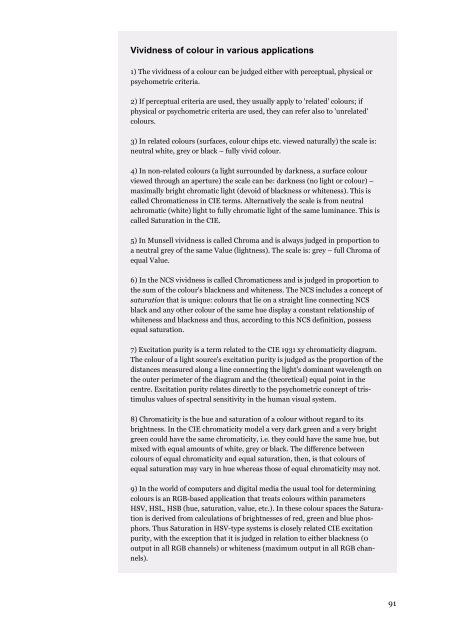Lightness and Brightness and Other Confusions
Lightness and Brightness and Other Confusions
Lightness and Brightness and Other Confusions
Create successful ePaper yourself
Turn your PDF publications into a flip-book with our unique Google optimized e-Paper software.
Vividness of colour in various applications<br />
1) The vividness of a colour can be judged either with perceptual, physical or<br />
psychometric criteria.<br />
2) If perceptual criteria are used, they usually apply to 'related' colours; if<br />
physical or psychometric criteria are used, they can refer also to 'unrelated'<br />
colours.<br />
3) In related colours (surfaces, colour chips etc. viewed naturally) the scale is:<br />
neutral white, grey or black – fully vivid colour.<br />
4) In non-related colours (a light surrounded by darkness, a surface colour<br />
viewed through an aperture) the scale can be: darkness (no light or colour) –<br />
maximally bright chromatic light (devoid of blackness or whiteness). This is<br />
called Chromaticness in CIE terms. Alternatively the scale is from neutral<br />
achromatic (white) light to fully chromatic light of the same luminance. This is<br />
called Saturation in the CIE.<br />
5) In Munsell vividness is called Chroma <strong>and</strong> is always judged in proportion to<br />
a neutral grey of the same Value (lightness). The scale is: grey – full Chroma of<br />
equal Value.<br />
6) In the NCS vividness is called Chromaticness <strong>and</strong> is judged in proportion to<br />
the sum of the colour's blackness <strong>and</strong> whiteness. The NCS includes a concept of<br />
saturation that is unique: colours that lie on a straight line connecting NCS<br />
black <strong>and</strong> any other colour of the same hue display a constant relationship of<br />
whiteness <strong>and</strong> blackness <strong>and</strong> thus, according to this NCS definition, possess<br />
equal saturation.<br />
7) Excitation purity is a term related to the CIE 1931 xy chromaticity diagram.<br />
The colour of a light source's excitation purity is judged as the proportion of the<br />
distances measured along a line connecting the light's dominant wavelength on<br />
the outer perimeter of the diagram <strong>and</strong> the (theoretical) equal point in the<br />
centre. Excitation purity relates directly to the psychometric concept of tristimulus<br />
values of spectral sensitivity in the human visual system.<br />
8) Chromaticity is the hue <strong>and</strong> saturation of a colour without regard to its<br />
brightness. In the CIE chromaticity model a very dark green <strong>and</strong> a very bright<br />
green could have the same chromaticity, i.e. they could have the same hue, but<br />
mixed with equal amounts of white, grey or black. The difference between<br />
colours of equal chromaticity <strong>and</strong> equal saturation, then, is that colours of<br />
equal saturation may vary in hue whereas those of equal chromaticity may not.<br />
9) In the world of computers <strong>and</strong> digital media the usual tool for determining<br />
colours is an RGB-based application that treats colours within parameters<br />
HSV, HSL, HSB (hue, saturation, value, etc.). In these colour spaces the Saturation<br />
is derived from calculations of brightnesses of red, green <strong>and</strong> blue phosphors.<br />
Thus Saturation in HSV-type systems is closely related CIE excitation<br />
purity, with the exception that it is judged in relation to either blackness (0<br />
output in all RGB channels) or whiteness (maximum output in all RGB channels).<br />
91
















